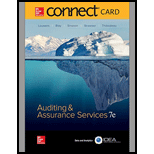
a.
Describe the factors that Mr. S should consider in establishing acceptable levels of the risk of incorrect acceptance and the risk of incorrect rejection.
a.
Explanation of Solution
The risk of incorrect acceptance is determined using the audit risk model based on prior assessments of audit risk, analytical procedures risk and risk of material misstatement.
If the initial results indicate that the account balance is materially misstated, the risk of incorrect rejection is determined based on cost to Mr. S which expands the sample. Mr. S will typically assess the risk of incorrect rejection at lower or higher levels, as the cost of expanding the sample increases or decreases.
b.
Explain the advantages and disadvantages of Mr. S’s establishing lower levels of the risk of incorrect acceptance and the risk of incorrect rejection.
b.
Explanation of Solution
Establishing lower levels of the risk of incorrect acceptance and the risk of incorrect rejection’s advantages are which the sample of Mr. S will have a likelihood of representing the population.
Thus, Mr. S’s sample evaluation allows Mr. S to make correct decision with respect to Mr. W’s
On the other hand, the disadvantage is that Mr. S has to select and evaluate a larger sample.
c.
Calculate the
c.
Explanation of Solution
The sample size: The sample size signifies the number of items that the audit team inspects within a population of interest. Four major aspects that impact the sample size in an “attributes sampling application” are as follows:
- “Tolerable rate of deviation”.
- “Sampling risk-risk of overreliance, or risk of assessing control risk too low.
- “Expected population deviation rate”.
- “Population size”.
Step 1: Calculate the tolerable misstatement.
Step 2: Calculate the expected misstatement.
Step 3: Calculate the sample size.
Notes:
N= number of individual customer accounts.
R (IA) = Risk of incorrect rejection.
R (IR) = Risk of incorrect acceptance.
SD = Standard Deviation.
TE= Tolerable Misstatement.
EE = Expected Misstatement.
Therefore, the sample size is 128 times.
d1.
Calculate the sample size, if Risk of incorrect acceptance of 5 percent, risk of incorrect rejection of 10 percent.
d1.
Explanation of Solution
Calculate the sample size.
Notes:
N= number of individual customer accounts.
R (IA) = Risk of incorrect rejection.
R (IR) = Risk of incorrect acceptance.
SD = Standard Deviation.
TE= Tolerable Misstatement.
EE = Expected Misstatement.
Therefore, the sample size is 107 times.
d2.
Calculate the sample size, if Risk of incorrect acceptance of 10 percent, risk of incorrect rejection of 5 percent.
d2.
Explanation of Solution
Calculate the sample size.
Notes:
N= number of individual customer accounts.
R (IA) = Risk of incorrect rejection.
R (IR) = Risk of incorrect acceptance.
SD = Standard Deviation.
TE= Tolerable Misstatement.
EE = Expected Misstatement.
Therefore, the sample size is 103 times.
d3.
Calculate the sample size, if Risk of incorrect acceptance of 10 percent, risk of incorrect rejection of 10 percent.
d3.
Explanation of Solution
Calculate the sample size.
Notes:
N= number of individual customer accounts.
R (IA) = Risk of incorrect rejection.
R (IR) = Risk of incorrect acceptance.
SD = Standard Deviation.
TE= Tolerable Misstatement.
EE = Expected Misstatement.
Therefore, the sample size is 84 times.
e.
Explain how the levels of sampling risks affect sample size based on the sample size calculation in requirement (c) and (d).
e.
Explanation of Solution
It shows the inverse relationship between sampling risks and sample size by comparing the sample sizes in requirement (c) and (d). For instance by relating the sample size with 5% risk of incorrect rejection and incorrect acceptance i.e. is 128 times (requirement (c)) with the sample size when the risk of incorrect rejection is 10 percent i.e. 107 times (requirement (d1)) or the risk of incorrect acceptance is 10% i.e. 103 times (requirement (d2)), it specifies when the sampling risk increases then the sample size decreases. This provides Mr. S the smallest sample size when both the sampling risks are increased to 10%.
Want to see more full solutions like this?
Chapter G Solutions
Connect Access Card for Auditing & Assurance Services

 AccountingAccountingISBN:9781337272094Author:WARREN, Carl S., Reeve, James M., Duchac, Jonathan E.Publisher:Cengage Learning,
AccountingAccountingISBN:9781337272094Author:WARREN, Carl S., Reeve, James M., Duchac, Jonathan E.Publisher:Cengage Learning, Accounting Information SystemsAccountingISBN:9781337619202Author:Hall, James A.Publisher:Cengage Learning,
Accounting Information SystemsAccountingISBN:9781337619202Author:Hall, James A.Publisher:Cengage Learning, Horngren's Cost Accounting: A Managerial Emphasis...AccountingISBN:9780134475585Author:Srikant M. Datar, Madhav V. RajanPublisher:PEARSON
Horngren's Cost Accounting: A Managerial Emphasis...AccountingISBN:9780134475585Author:Srikant M. Datar, Madhav V. RajanPublisher:PEARSON Intermediate AccountingAccountingISBN:9781259722660Author:J. David Spiceland, Mark W. Nelson, Wayne M ThomasPublisher:McGraw-Hill Education
Intermediate AccountingAccountingISBN:9781259722660Author:J. David Spiceland, Mark W. Nelson, Wayne M ThomasPublisher:McGraw-Hill Education Financial and Managerial AccountingAccountingISBN:9781259726705Author:John J Wild, Ken W. Shaw, Barbara Chiappetta Fundamental Accounting PrinciplesPublisher:McGraw-Hill Education
Financial and Managerial AccountingAccountingISBN:9781259726705Author:John J Wild, Ken W. Shaw, Barbara Chiappetta Fundamental Accounting PrinciplesPublisher:McGraw-Hill Education





